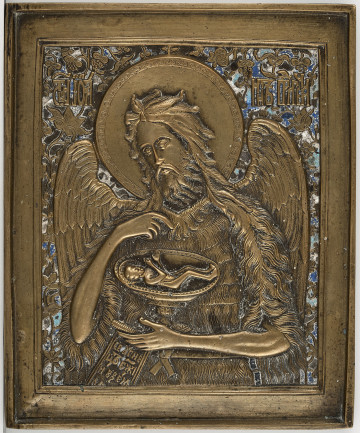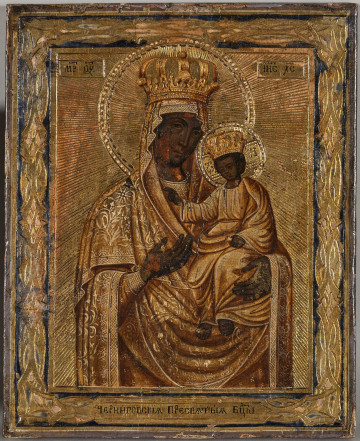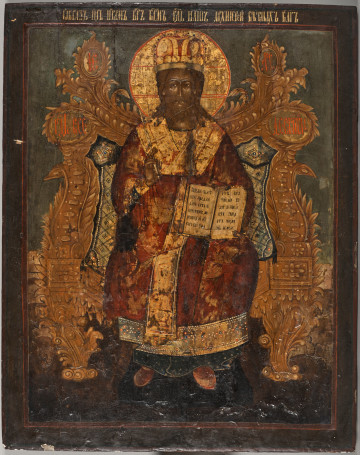
St. John the Baptist
20th century
Castle Museum in Łańcut
Part of the collection: Icons
Objects cast from metal alloys were initially brought to Rus from Byzantium. Since the 12th c., they were produced in local workshops in the Kievan Rus, then in Veliky Novgorod and Pskov, in Moscow and in the provinces. Initially, these products emulated Byzantine models. Over time, local forms and types developed in Rus. In the 17th c., after the schism in the Orthodox Church of the Moscow Patriarchate, the opponents of liturgical reform fled to the inaccessible areas of the Russian coast of the White Sea. The bishop Paul of Kolomna, who opposed the reform, began building a community of Russian Old Believers in 1655. After the Tsar's troops seized the Solovetsky Monastery in 1676 and slaughtered most of the Old Believer monks, a hermitage was established on the Vyg in 1695. The hermitage was the successor to the Solovietsky Monastery and the stronghold of the anti-reform Old Ritualists. Not recognising the new icons, the Old Ritualists on the Vyg developed their own books and objects of worship; they made crosses and icons from metal alloys, frequently decorated with enamel. In the middle of the 19th c., as a result of persecution, the Vyg hermitage was closed and Moscow became the principal centre of production of metal objects of worship. The types of metal products first developed on the Vyg became popular throughout Russia; they had been replicated and copied all the way until the 20th c. These include folding icons, in Russian - 'składieny', including four-winged polyptychs topped with kokoshniks, like the displayed exhibit. Three wings of the icon depict the Twelve Great Feasts of the liturgical year, known as 'dwunadziesiatyje prazdniki'; see S.12860MŁ, S.12861MŁ. The fourth wing shows popular depictions of the Mother of God: Theotokos of Tikhvin, Vladimir, and Smolensk, and the Our Lady of the Sign icon type. On the kokoshnik at the top, Synaxis of the Theotokos, which can be seen on the icon. On the richly decorated face of the icon, when closed, there is a depiction of Golgotha with an eight-pointed cross as the instrument of the Passion of Christ. Teresa Bagińska-Żurawska https://orcid.org/0000-0002-9243-3967
Other names
Great Christmas
Dimensions
height: 13.5 cm, width: 35.9 cm
Object type
Icons
Technique
cast
Material
brass
Origin / acquisition method
decyzja administracyjna
Creation time / dating
Creation / finding place
Owner
Castle Museum in Łańcut
Identification number
Location / status

20th century
Castle Museum in Łańcut

19th (?) century
Castle Museum in Łańcut

1800 — 1850
Castle Museum in Łańcut
DISCOVER this TOPIC
Museum of King Jan III's Palace at Wilanów
DISCOVER this PATH
Educational path